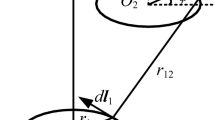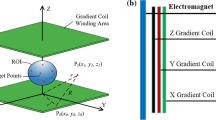Abstract
Objective
Conventional single-target field control for matrix gradient coils will add control complexity in MRI spatial encoding, such as designing specialized fields and sequences. This complexity can be reduced by multi-target field control, which is realized by optimizing the coil structure according to target fields.
Methods
Based on the principle of multi-target field control, the X, Y and Z gradient fields can be set as target fields, and all coil elements can then be divided into three groups to generate these fields. An improved simulated annealing algorithm is proposed to optimize the coil element distribution of each group to generate the corresponding target field. In the improved simulated annealing process, two swapping modes are presented, and randomly selected with certain probabilities that are set to 0.25, 0.5 and 0.75, respectively. The flexibility of the final designed structure is demonstrated by a spherical harmonic basis up to the full second order with single-target field control. An experimental platform is built to measure the gradient fields generated by the designed structure with multi-target target control.
Results
With three probabilities of swapping modes, three similar coil element distributions are optimized, and their maximum magnetic field errors for generating X, Y and Z gradients are all below 5%. The structure selected for the final design is the one with a probability of 0.75, considering the coil performance and structural symmetry. The maximum error for all target fields generated by single-target field control is also below 5%. The experimental results show that the measured gradient fields along the axes have enough strength and high linearity.
Conclusions
With the proposed improved simulated annealing algorithm and swapping modes, multi-target field control for matrix gradient coils is verified and achieved in this study by optimizing the coil element distribution. Moreover, this study provides a solution to simplify the complexity of controlling the matrix gradient coil in spatial encoding.















Similar content being viewed by others
Data availability
The datasets generated and analyzed during the current study are available from the corresponding author on reasonable request.
References
Wintzheimer S, Driessle T, Ledwig M, Jakob PM, Fidler F (2010) A 50-channel matrix gradient system: a feasibility study. In: Proceedings of the joint annual meeting ISMRM-ESMRMB, Stockholm, Sweden, p 3937
Juchem C, Nixon TW, McIntyre S, Rothman DL, de Graaf RA (2010) Magnetic field modeling with a set of individual localized coils. J Magn Reson 204:281–289
While PT, Korvink JG (2014) Designing MR shim arrays with irregular coil geometry: theoretical considerations. IEEE Trans Biomed Eng 61:1614–1620
Kroboth S, Layton KJ, Jia F, Littin S, Yu H, Hennig J, Zaitsev M (2018) Optimization of coil element configurations for a matrix gradient coil. IEEE Trans Med Imaging 37:284–292
Zivkovic I, Mirkes C, Scheffler K (2016) B0 shimming at 9.4T using a multicoil approach: coil design with genetic algorithm. In: 24th Annual Meeting and Exhibition of the ISMRM, Singapore, p 1152
Zivkovic I, Tolstikhin I, Schölkopf B, Scheffler K (2016) B0 matrix shim array design-optimization of the position, geometry and the number of segments of individual coil elements. In: 33rd Annual Scientific Meeting Magnetic Resonance Materials in Physics, Biology and Medicine, Vienna, Austria, S36
Jia F, Littin S, Layton KJ, Kroboth S, Yu H, Hennig J, Zaitsev M (2017) Design of a shielded coil element of a matrix gradient coil. J Magn Reson 281:217–228
Littin S, Jia F, Layton KJ, Kroboth S, Yu H, Hennig J, Zaitsev M (2018) Development and implementation of an 84-channel matrix gradient coil. Magn Reson Med 79:1181–1191
Chen W, Chen J, Sun H, Chen Z (2019) Simulation and analysis of irregular multicoil B0 shimming in C-type permanent magnets using genetic algorithm and simulated annealing. Appl Magn Reson 50:227–242
Aghaeifar A, Zhou J, Heule R, Tabibian B, Schölkopf B, Jia F, Zaitsev M, Scheffler K (2020) A 32-channel multi-coil setup optimized for human brain shimming at 9.4T. Magn Reson Med 83:749–764
Xu YJ, Yu P, Jia F, Wang Y, Yu YC, Yang XD, Zaitsev M (2022) A spherical harmonics decomposition method (SHDM) for irregular Matrix Coils design. IEEE Trans Biomed Eng 69:1292–1301
Turner R (1993) Gradient coil design: a review of methods. Magn Reson Imaging 11:903–920
Juchem C, Nahhass OM, Nixon TW, de Graaf RA (2015) Multi-slice MRI with the dynamic multi-coil technique. NMR Biomed 28:1526–1534
Panych LP, Madore B (2017) The physics of MRI safety. J Magn Reson Imaging 47:28–43
Juchem C, Green D, de Graaf RA (2013) Multi-coil magnetic field modelling. J Magn Reson 236:95–104
He HY, Wei SF, Wang HX, Yang WH (2022) Analysis of coil element distribution and dimension for matrix gradient coils. Magn Reson Mater Phys Biol Med 35:967–980
Kirkpatrick S, Gelatt CD, Vecchi MP (1983) Optimization by simulated annealing. Science 220:671–680
Poole M, Bowtell R (2007) Novel gradient coils designed using a boundary element method. Concepts Magn Reson Part B (Mag Reson Eng) 31B:162–175
Marler RT, Arora JS (2004) Survey of multi-objective optimization methods for engineering. Struct Multidiscip Optim 26:369–395
Acknowledgements
This work was supported by the Major Program of the National Natural Science Foundation of China (Grant NO. 52293423 and NO. 52293425), the Major Science and Technology Innovation Program of Shandong (No. 2021CXGC010504), and the Science and Technology Program of Baoding (NO. 2211G004).
Author information
Authors and Affiliations
Corresponding author
Ethics declarations
Conflict of interest
All other authors declare that they have no conflicts of interest.
Ethical standards
The manuscript does not contain clinical studies, patient, or volunteer data.
Additional information
Publisher's Note
Springer Nature remains neutral with regard to jurisdictional claims in published maps and institutional affiliations.
Rights and permissions
Springer Nature or its licensor (e.g. a society or other partner) holds exclusive rights to this article under a publishing agreement with the author(s) or other rightsholder(s); author self-archiving of the accepted manuscript version of this article is solely governed by the terms of such publishing agreement and applicable law.
About this article
Cite this article
He, H., Wei, S., Wang, H. et al. Multi-target field control for matrix gradient coils. Magn Reson Mater Phy 37, 185–198 (2024). https://doi.org/10.1007/s10334-023-01143-6
Received:
Revised:
Accepted:
Published:
Issue Date:
DOI: https://doi.org/10.1007/s10334-023-01143-6




